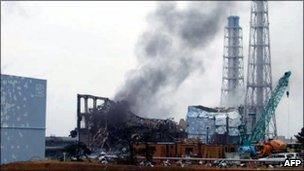Fukushima: 'Small increased cancer risk'
- Published

The Fukushima plant was devastated by an earthquake and tsunami
People living near the damaged Fukushima nuclear plant in Japan have an increased risk of developing some cancers, the World Health Organization says.
The increased risk is limited to communities and some emergency workers exposed to radiation after the 2011 earthquake and tsunami, analysis shows.
For those living in the rest of Japan there is no health risk, it said.
Experts stressed the increased lifetime risk of cancer remained small.
The report is part of an ongoing assessment by international experts on the fallout from severe damage to the Fukushima Daiichi plant.
In March 2011, a powerful tsunami generated by a magnitude-9.0 earthquake out at sea slammed into the nuclear power plant in north-eastern Japan, damaging four of six reactors at the site.
Around 16,000 people were killed by the impact of the earthquake.
A substantial amount of radiation was released into the environment and a 20km (12 miles) evacuation zone was set up.
The latest analysis has found that those living in the most contaminated areas around Fukushima are expected to have a small but higher than expected risk of cancer.
The biggest lifetime risks were seen in those exposed as infants, compared with children or adults.
For girls exposed to radiation from the accident as infants, the report found a 4% increase above the lifetime expected risk of solid tumours and a 6% increase above that expected for breast cancer.
Boys exposed as infants are expected to have a 7% increased risk of leukaemia above that expected in the normal population.
The biggest risk was seen in thyroid cancer, which for infant girls could be up to 70% higher than expected over their lifetime.
Demographic factors
But the WHO was keen to stress that these risks were relative and remained small.
For example, the lifetime risk of developing thyroid cancer over a lifetime for women is 0.75% and the additional risk for those exposed as infants in the most affected area is 0.50%.
The report also found that a third of emergency workers working in the plant after the disaster are at an increased risk of cancer.
Radiation doses from the damaged nuclear power plant are not expected to cause an increase in the incidence of miscarriages, stillbirths or congenital disorders.
Dr Maria Neira, WHO director for public health and environment, said: "The primary concern identified in this report is related to specific cancer risks linked to particular locations and demographic factors."
She added that the report underlined the need for long-term health monitoring of those who were at high risk, along with medical follow-up and support.
"This will remain an important element in the public health response to the disaster for decades."
Prof Richard Wakeford, visiting professor at Dalton Nuclear Institute at the University of Manchester and contributor to the WHO report, said: "The release of radioactive materials into the environment during the Fukushima nuclear accident was substantial but based on measurement data, the radiation doses received by the surrounding population are small, even for the most exposed communities.
"These doses produce an extra risk of cancer over a lifetime of about 1% at most, in addition to background lifetime cancer risks from all other causes of, on average, 40% for men and 29% for women."
He added: "Radiation exposure from the Fukushima accident has had only a small impact on the overall health of the nearby population, and much less outside the most affected areas."
- Published3 January 2013
- Published24 May 2012
- Published21 July 2011
- Published12 September 2011